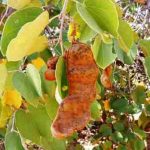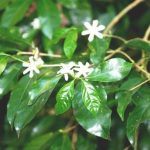TREE LIFE
OCTOBER 1994
MASHONALAND CALENDAR
Tuesday 4th October. Botanic Garden Walk at 4.45 for 5 p.m. We will meet Tom in the public car park of the Gardens and continue where we left off last month with Rubiaceae.
Sunday 16th October. Lyndhurst Farm. On our recce we found an area of unspoilt riverine woodland near the dam and some remains of ancient walling complete with Diospyros natalensis in the rocks above. Hopefully a few trees will be in flower. . We meet at 9.30 a.m.
Saturday 22nd October. Mark’s Walk this month will be at the Mukuvisi Woodlands which always has something to interest us. Meet at the Paget Rd/Inyanga Crescent entrance to the woodlands at 3.00 p.m. as usual. There will be someone to guard the cars.
Tuesday 1st November. Botanic Garden Walk.
MATABELELAND CALENDAR
Sunday 2nd October. A full length video on the Rift Valley. At Girls’ College at 10.00 a.m. Tea will be provided.
Wednesday 5th October. Dr Peter Apps will be presenting an illustrated talk on animal behaviour, “Wild Ways” at the Rio at 6.00 p.m. for dinner at 6.30 ($17,50) Contact On Safari International, P 0 Box 594, Harare to reserve a place.
Sunday 6th November. Inungu – Matopos. Half or all day outing, from Girls’ College at 8.30 a.m.
TWYFORD FARM 21 August 1994
Although we only covered about 50 metres through the unspoilt riverine woodland, Cam Meredith’s knowledge of the area and Meg’s “Tree Labels” made a really Interesting walk along the bend in the Mupfure River.
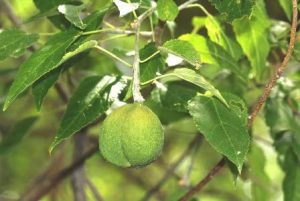
Croton megalobotrys. Photo: Bart Wursten. Source: Flora of Zimbabwe
“Three veins from the base” was an important phrase of the day and we used it when we looked at Croton megalobotrys with its egg shaped leaf and two tiny glands, where the stalk joins the leaf blade. Parts of the tree are known to have anti-malarial properties but the seeds deep within the nearly rounded fruit have another use – the oil is a powerful laxative. The aptly named Pouched Mouse is known to gather the fruit and transport it, crammed into its cheeks back to its burrow where the husks are discarded. The mouse’s messy habits around its home and with its sluggish movements make Pouched Mouse Pie a reality for a passing predator!
Other trees noted were Bauhinia petersiana with its peculiar “twisted twigs” and Strychnos potatorum, another “3 veins from the base” with glossy black fruits of dubious reputation. Some of the other understorey trees were Allophylus africanus with short petioles on the lateral leaflets, Grewia flavescens and a superb Dombeya rotundifolia. The upper story had a few Diospyros mespiliformis but was dominated by dozens of magnificent Kigelia africana. Whilst tripping over the sausage-like fruit concealed in the piles of dry leaves we came across a single maroon flower, wilted but still very interesting to see at close range. As soon as one of the many flowers (54 have been counted) on the string or peduncle, has been pollinated by a bat, the rest get the message and abort, thereby alleviating the necessity for the string to hang on to possibly 54 x 10 kg fruits.
A less common species noted was Ficus sycomorus. Their characteristic yellow green trunks were covered in a vast array of small scars – a reminder of the stipules that were once there. A few small specimens of the spiny climber Combretum mossambicense appeared now and then through the ‘woodland.
Mid afternoon brought the icy south easterly wind and being short of jerseys the walk ended suddenly as we sought the comfort of a vehicle. To Cam and Niven thank you for letting us share your delightful woodland walk and for stocking up the kiosk. Many thanks to Meg for leading such an interesting walk.
-Andy Macnaughtan
BULAWAYO TREE SOCIETY MEETING 4 SEPTEMBER 1994
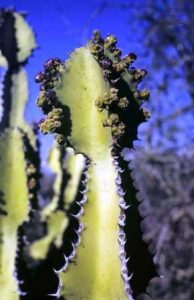
Euphorbia confinalis. Photo: Darrel Plowes. Source: Flora of Zimbabwe
Emerging from hibernation due to the worst winter since 1968, the Bulawayo Tree Society proceeded down the Plumtree Road, turning south on the Ravenswood Road, our major goal to find the Euphorbia confinalis. We were accompanied by members of the Harare Tree Society, one of whose younger members shared his birthday cake with us.
We encountered results of the “black frost” in most areas throughout the day, but there were a few areas that had escaped and remained verdant. As the Matobo hills came into view, soaring eagles appeared, thought to be black eagles.
As we approached more closely to the hills, Euphorbia confinalis appeared in multitudes. This being our major target for the day we disembarked and ascending the slopes encountered the Euphorbia confinalis trunks, but were unable to touch the branches. We also saw Euphorbia ingens and Euphorbia cooperi in the Matopos. Euclea racemosa, Euclea natalensis and Euclea divinorum appeared to be semper virens, except where they were “burnt” with the extreme frigidity of 1st July. Grewia flavescens was identified with square branches and Grewia monticola and Grewia retinervis by fruits and occasional dried leaf.
The discoveries of the day (for this observer) were 1. Homalium dentatum and 2. Steganotaenia araliacea. A visitor from Harare reported the carrot tree was common and we found it in early flower with the multiple umbels and no leaves.
Homalium dentatum had a tall bole, with the leaves far out of reach in a circular mass. Species little affected by the cold insult, being Semper virens, or partly so, were Vepris reflexa, Olea europaea, Rhus leptodictya, Rhus lancea, Mimusops zeyheri, Tarenna neurophylla, Tarenna zimbabwensis, Lonchocarpus capassa, 0zorea insignia, Pappea capensis, and others. Deciduous specimens were identified by observing retained dry leaves, retained pods and bark characteristics, such as Peltophorum africanum, Flacourtia indica, Gardenia volkensii, Mundulea sericea, Pavetta eylesii, Azanza garckeana, Allophylus africanus, Albizia amara. Combretum molle, Combretum apiculatum, Combretum zeyheri, Commiphora mollis and Commiphora pyracanthoides. We probably saw Commiphora schimperi also.
On further ascension of the hills, we found a protected area, discovering Catha edulis, Cordia grandicalyx, Olax dissitiflora, Croton gratissimus, Heteropyxis dehniae, and others, all with full leaf development.
On descending a hill, a large Diospyros mespiliformis appeared, fully developed with rounded green fruit 1½” in diameter. Many Cassine matabelica, oops, Elaeodendron matabelicum trees and shrubs could be found, many with well developed panicles of flower buds. Also we found a portion of limb with curling flower stalk, indicating Artabotrys brachypetalus.
After further driving several kilometres, a shady spot for lunch was found, the shade produced by dried, twisted, contorted Pterocarpus rotundifolius leaves. What a magnificent umbrage this area would produce in January! On resumption of hill climbing towards Hendrik’s Pass, we encountered colonies of Aloe chabaudii, small shrublets of 0chna pulchra and just short of Hendrik’s Pass, large bare Albizia tanganyicensis, Commiphora marlothii and Entandrophragma caudatum were discovered, one member taking home a peeled banana (wooden).
Throughout the day wild pear trees, Dombeya rotundifolia were seen in all their glory, along with Euphorbia cooperi and Euphorbia ingens. Piliostigma thonningii was encountered frequently, as was and Aloe excelsa. We were scratched by Dichrostachys cinerea and many Acacias, (Acacia galpinii, Acacia karroo, Acacia nigrescens, Acacia tortilis and Acacia rehmanniana). Maybe not you, but certainly me!
Some members found Albizia versicolor, Bolusanthus speciosus, Brachylaena rotundata and Brachylaena huillensis, plus Brachystegia glaucescens. Other members found Terminalia sericea (without any leaves) Ziziphus mucronata, Pouzolzia mixta, Psydrax livida, Pterocarpus angolensis, (with pods) Pseudolachnostylis maprouneifolia, Schrebera alata, and Strychnos madagascariensis. As always in the Matopos, there was an abundance of Strychnos matopensis, Maytenus heterophylla subsp. puberula, Barleria albostellata and Euphorbia griseola.
Not to be outdone, several fig trees made their appearance (Ficus ingens, Ficus sur, Ficus tettensis, Ficus glumosa and Ficus abutilifolia) along with Kirkia acuminata, Hexalobus monopetalus, Flueggea virosa, Sterculia africana, Zanthoxylum capense and others.
Who can’t identify Lannea discolor with all the end branches showing small green buds (no leaves)? But who can identify Ximenia caffra with one dried up leaf and one slightly hairy branchlet? (Well somebody can!). How about labelling a Marula (Sclerocarya birrea) as a Burkea; well it has brown at the end of the branchlets and retained seed stalks! But the brown is not reddish and hairy and besides, you did not look at the trunk. Can you tell I took Meg Palgrave’s course??
Hey! you guys Who found Strychnos usambarensis, Nuxia oppositifolia and Swartzia madagascariensis without showing them to me?? Well, I got even with you. I feasted on a panoramic view of Matabeleland in the springtime from the large back window of a Landcruiser, returning to Bulawayo on the Kezi road!
P.S. Let’s go to Harare and visit their Tree Society!
-Tom Raub.
A FOOTNOTE TO THE BULAWAYO MEETING OF 4 SEPTEMBER 1994
This visit was billed as an excursion to the Tendele River and Hendrik’s Pass and indeed this was one of our objectives, as it so frequently is, to combine botany and history.
The Hendrik referred to is Andries Hendrik Potgieter the famous Trek-Boer leader, nicknamed Ndaleka by the Matabele. In 1847, for a variety of motives, one of which was to rescue the little Liebenberg girls who had been kidnapped by Mzilikazi’s soldiers near Parys, he crossed the Limpopo near its confluence with the Shashi and headed northwards. Near Fumukwe (one of the largest hills in the south western Matopos) he encountered the Mncwazini Regiment, who in a dawn raid were massacred, almost to a man. Their cattle were driven back to the Boer laager and Potgieter with some of his men pushed forward on horseback exploring a narrow passage through the hills to reach the tablelands of the highveld. This gap running parallel to the Tendele River is marked on the 1:50000 map (Mpopoma 2028 C2). To this day the Ndebele call it Ekalweni lu ka Ndaleka, or Hendrik’s pass. The rest of the story and the further adventures of Potgieter can be found in Tredgold’s book on the Matopos and in two of T V Bulpin’s popular histories The Golden Republic and Shaka’s Country.
Our visit took us to within three or four kilometres of the pass. Time and the legendary pace of the Tree Society denied us our objective but nevertheless provided an excellent excuse for a return visit.
–Ian McCausland
BOTANIC GARDEN WALK 6TH SEPTEMBER, 1994
The Rubiaceae is one of the largest flowering plant families – about 7000 species in 500 genera, providing coffee, drugs (quinine etc.) ornamentals (Gardenia etc.) and dyes.
The features common to all Rubiaceae are so easy to see, that it is a simple matter to spot a plant belonging to this family. However, beyond that, to genus and species level it is much trickier.
Briefly, the features are: leaves are opposite or whorled, simple and entire, stipules are present between leaf stalks (interpetiolar). Flowers are usually bisexual, floral parts are in fours or fives with petals being fused and stamens borne on the corolla tube, the ovary is inferior arid the fruit is usually crowned with the persistent remains of the calyx lobes.
With this bit of basic knowledge we followed Tom into the Middle and Low Altitude Rain Forest section of the Botanical Garden where he showed us some of the forest species in the family.
The first was Pyrostria bibracteata shaped a little like a Christmas tree tapering upward with well spaced branches and in common it seems with all forest species, it has shiny dark green leaves. This species is found in the Vumba and southwards into Burma Valley as well as in the Haroni/Rusitu forest.
Canthium pseudoverticillatum, a fairly rare, dainty little shrub of regular growth pat tern is found at low altitudes at forest edges.
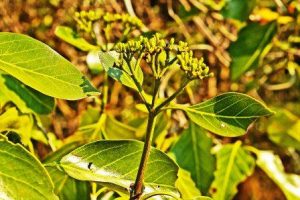
Tarenna zimbabwensis. Photo: Meg Coates Palgrave. Source: Flora of Zimbabwe
Tarenna supra-axillaris also occurs on the forest edges and has smaller leaves than Tarenna neurophylla with which we are familiar. Tarenna pavettoides occurs at 1300/1400 meters and below in the Chirinda, Stapleford and Haroni/Rusitu forests. Tarenna zimbabwensis commonly occurs in the Watsomba and Bikita districts as well as in the Matopos, which is an Eastern Districts outlier. It has a very distinct and large assegai shaped stipules and a stiff upright growth pattern.
Near Leopard Rock there is a 3 or 4-acre stand of Tricalysia pallens. This species is common in disturbed ground at Chirinda forest such as near Swynnerton’s homestead. A species vaguely familiar was Didymosalpinx norae, named by Swynnerton after his wife. It occurs in Chirinda and is a pretty tree especially when in flower with 2 cm bell-shaped flowers. The fruit takes two years to ripen which explains why there was green fruit on one of the trees in the garden at this time of year.
Two species of Oxyanthus were discussed – Oxyanthus goetzei uncommon in the forests, and Oxyanthus speciosus, which has a fluted stern and is seen fairly frequently nearer to Harare i.e. on Ngomakurira.
Related to coffee and looking very like it was Cremaspora triflora. It has big sessile leaves, and the white scented flowers are clustered in the axils of the leaves.
Tom told us that about 5% of forest trees are deciduous, and one of those which we looked at (leafless) was Vangueria esculenta. This species grows to height of 20 meters in Chirinda Forest. As we emerged from the forest in the fading evening light we passed Rothmannia urcelliformis in flower, very attractive cream coloured, wide bells with painted throats. The golf bail size fruit, which also takes two years to ripen stains purple/black if damaged. The other Rothmannia, Rothmannia manganjae was not yet flowering which seemed to surprise Tom.
Next month we continue the search for the elusive Psydrax!
Thank you Tom for a delightful walk.
-Maureen Silva Jones
GILNOCKIE 18 SEPTEMBER 1994
The washing gang doing their chores fled on our approach leaving us free to explore the river bed and fringe, not to mention a quick look for the legendary python in the rocks.
An island below the water stained rock shelf had in its rocky clutches a magnificent Ansellia africana (Orchidaceae) resplendent with its yellow flowers which also had a number of curious purple dots on the petal surface. Among the rocks was also a variety of what we saw later along the river, from the very common and dusty looking Dalbergia nitidula to the water loving Salix subserrata.
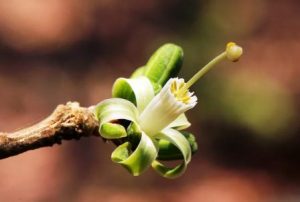
Turraea nilotica. Photo: Bart Wursten. Source: Flora of Zimbabwe
The rustlings of early summer were noticeable with the numbers of flowering trees ranging from Bequaertiodendron magalismontanum (oops Englerophytum magalismontanum) with its curious red blooms popping out from the stems to the delicate yellow blossom of Turraea nilotica.
Only a few Figs were encountered, Ficus natalensis with its truncated and rather brittle leaf, Ficus sur with larger serrated leaves and a Ficus verruculosa hiding in the river bed. A less common find was that of Faurea saligna subsp. B, the red petioles being noticeably different and the leaf blades wider.
Up the steep path to the area where blasting had taken its toll of the surrounds, the Brachystegia woodland was already green and only a few traces of the copper hue were seen. The piles of blasted granite below the proposed dam wall reflected considerable heat and to judge by the amount of water and fizzies being gulped down an early break was necessary before heading off to the Binga Swamp Forest.
As expected the “forest” was extremely dry and the large Syzygium cordatum within its fringes showed signs of die back on all the upper branches. Celtis africana, Rhamnus prinoides and Rhus longipes all tangled together in the under¬storey making walking difficult but similar to a riverine environment. In a nearby stream along with Ilex mitis we upset a group of terrapins taking a breather from their stagnant pool.
Many thanks to Peter Clark for letting us have a look at Gilnockie twelve years on and we look forward to seeing the completed dam in the future.
-Andy Macnaughtan
NYARUPINDA CATCHMENT September 1994
The Scene
The Spring weather had been unusually calm until the night of 8/9 September when a gale tore at the trees and rattled all the doors and windows. Despite this violence the night sky was cloudless and starry, the constellation Southern Cross was low in the southwest.
The identity of the Hornbill. Please refer to my ‘bit’ in Tree Life No. 175. An unintentionally amusing letter from the Zoology Department at the Museum in Harare advised me that the crashed bird specimen was identified as a Crowned Hornbill – Tockus alboterminatus. They are common in Zimbabwe mainly along the Zambezi valley. It was picked up near the Nyarupinda dam a long way from its home.
My apologies for a garbled sentence in ‘August’s Palette‘, perhaps it is time for me to stop writing. Here is the correction…’ little droplets of gum on the twigs of forget-me-not tree, Ehretia obtusifolia….’
For economic reasons our journal Tree Life has fewer pages, consequently the topic Frost its Effects on Plants will be presented in three parts.
Pearls of wisdom have been found in texts by Jack Hattle, his Meteorology in Bundu Book 4; Street and Opik in Physiology of Flowering Plants 1983 edition. P.P. Banks The June 1968 Frosts in Science News April 1969; V.R. Gardner Basic Horticulture and finally M.V.B. Roberts excellent Biology: A Functional Approach 1975 edition. The texts are out of date but better than nothing.
Part 1 Ground Temperatures and Frost. Zimbabwe experiences only radiation frosts as distinct from ‘advective’ frosts which are caused directly by the influx of sub-zero air.
The development of radiation frosts requires cold dry air, clear skies and calm conditions – no wind, when these occur in the evening after a sunny day the surface of the ground loses heat by conduction and radiation and cools the air in contact with it. If this continues throughout the night, the temperature becomes very low at or near ground level, but temperatures at higher levels are not affected. This phenomenon is the reverse of daytime temperatures which are generally highest at ground level and decrease with elevation. This ‘inversion’ of temperature is characteristic of ‘radiation’ frost conditions.
Black Frost occurs when the air is exceptionally dry and the temperature falls to below freezing point without any condensation of moisture, this causes the sap in exposed vegetation to freeze. The blackened foliage killed in this way describes this type of frost.
White or Hoarfrost has the form of silvery ice needles which occur when the air is moist and the water vapour condenses and freezes – it is frozen dew.
Here are two reasons why hoarfrost may not be as severe as a black frost:
1. When the air near the ground is humid it can absorb radiation and thus retain heat.
2. When moisture in the air condenses forming dew and hoarfrost, latent heat is released and this inhibits freezing temperatures.
Natural Dyes from Trees See Tree Life No. 165
Veronica Roodt has written a guide to the trees of the Okavango delta, she mentions that the leaves of Terminalia sericea contain a blue dye.
Can Thora or Ken Hartley suggest a herbal remedy and its preparation for tearful horses?
-Benedicta Graves.
THORA’S HERBAL REMEDIES
1. BULRUSH – Typha capensis
This bulrush grows throughout Southern Africa along rivers, streams and beside dams it can be very invasive. The long strap-like leaves are used for thatching, mat and basket making by many African people. The plant also has its medicinal values.
A tea made from the root and lower stem is used in the treatment of dysentery, bowel haemorrhage and enteritis. The usual dose is 1-2 tablespoons taken every half hour until the condition clears. This tea is a blood cleanser and is used in treating bladder infections and as an external wash. A much stronger decoction of root and lower stem treats venereal diseases taken both internally and used externally. This brew also assists the delivery of the afterbirth in women and animals.
The leaves softened and twisted make ideal bandages to keep a dressing in place and the soft woolly seed-heads staunch bleeding when packed round wounds or used as absorbent pads. The large warmed leaf of the castor-oil plant (Ricinus communis) placed over a sprain and held in place by these strap-like leaves will draw the swelling, pain and extra water out from a sprained ankle enabling the patient to walk easily again.
The root and lower part of the stem are edible and new young shoots that appear above the mud can be cooked like asparagus and eaten with butter and salt. The mature root can be ground into meal and made into flat cakes, quite as nutritious as rice and mealies, but perhaps not quite as tasty.
Farmers often use the chopped up roots and stems to feed pigs and cattle.
If anyone has a copy of Wayward Winds for sale please contact Maureen Silva-Jones at home.
ANDY MACNAUGHTAN CHAIRMAN


